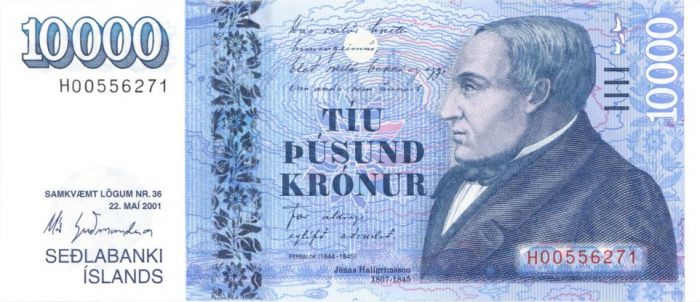Iceland - P-New - Icelandic Krona - Foreign Paper Money
Inv# FM2602 Foreign Paper Money
10,000 Kronur, P-New. Security strip!
The króna or krona (sometimes called Icelandic crown; sign: kr; code: ISK) is the currency of Iceland. Iceland is the second smallest country by population, after the Seychelles, to have its own currency and monetary policy.
Like the Nordic currencies (such as the Danish krone, Swedish krona and Norwegian krone) that participated in the historical Scandinavian Monetary Union, the name króna (meaning crown) comes from the Latin word corona ("crown").
The name "Icelandic crown" is sometimes used alternatively, for example in the financial markets.
The Danish krone was introduced to Iceland in 1874, replacing the earlier Danish currency, the rigsdaler. In 1885, Iceland began issuing its own banknotes.
The Icelandic krona separated from the Danish krone after the dissolution of the Scandinavian Monetary Union at the start of World War I and Icelandic sovereignty from Denmark in 1918. The first coins were issued in 1922.
Iceland was forced to devalue the Icelandic krona in 1922, by 23% against the Danish krone, which saw the beginning of an independent monetary policy in Iceland, and was to be the first of many subsequent devaluations of the krona.
In 1925 the krona was pegged to the British pound for the next 14 years until the spring of 1939. Later in 1939 the currency was pegged to the US Dollar, which was maintained until 1949.
The first notes issued in 1885 by the Landssjóður Íslands were in denominations of 5, 10 and 50 krona. In 1904, the Bank of Iceland (Íslands Banki) took over note production and introduced 100 krona notes. In 1921, the Ríkissjóður Íslands began issuing paper money, with notes for 1, 5, 10 and 50 krona.
In 1928, another bank, the Landsbanki Íslands, took over issuance of denominations of 5 krona and above, with the Ríkissjóður Íslands continuing to issue 1 krona notes until 1947. The Landsbanki Íslands introduced 500 krona notes in 1935, followed by 25- and 1000-krona notes in 1957.
In 1961, the Seðlabanki Íslands became the central bank of Iceland and started issuing paper money, in denominations of 10, 25, 100, and 500 krona. They were manufactured in England by De la Rue.
In 1981, the Icelandic krona was revalued, due to high inflation, with 100 old krona (ISJ) being worth 1 new krona (ISK) and a new 500 krona banknote was first put into circulation in 1981. The 1000 krona was put into circulation in 1984 and the 5000 krona in 1986. The 2000 krona banknote was put into circulation in 1995 but never became very popular. The 10,000 krona banknote was put into circulation in 2013.
Icelandic banknotes are printed with the dates from which the legal basis of the currency derives. In 1981, notes were issued in denominations of 10, 50, 100 and 500 krona based on the law of 29 March 1961. 1000 krona notes were introduced in 1984, followed by 5000 krona notes in 1986 with the same law.
100, 500, and 1000 krona notes were reissued in 1994 under the law of 5 May 1986. In the following year, a new denomination of 2000 krona was issued for the first time. The 2000 krona note is subtly different from the other notes. For example, the underprint pattern extends all the way upward and downward, while the other denominations had white margins on every side. The number 2000 is printed in multi color for 3 of the 4 occurrences. And the numeral 2000 on the lower left corner of reverse is vertical. The "shadow" of the numeral is printed with SÍ in microprint.
The 22 May 2001 series, saw substantial changes. The underprint and microprint features of the 2000 krona note were extended to other denominations. The 1000- and 5000-krona notes also received metallic foils next to the portrait.
In 2013, a new 10000 krona banknote was introduced. The face of natural scientist and poet Jónas Hallgrímsson appears on the bill, as well as the Eurasian golden plover. Notes of 100 krona or less are no longer in circulation, as they have been withdrawn by the central bank.










Ebay ID: labarre_galleries